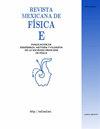物体在无摩擦台上旋转的问题,附在悬挂物体上,用守恒定理部分求解
Q4 Social Sciences
引用次数: 0
摘要
力学的守恒定理已经应用于由一个物体在无摩擦台上旋转组成的问题,该物体附着在一个悬挂的物体上,作为一个不了解复杂数学方法的物理学学生的例证,如何获得系统物理行为的描述,当获得运动方程需要那些复杂的方法时。应用角动量守恒,表明角频率的增加与运动半径的平方成反比;然后找到向心力和弦张力相互补偿的半径;然后,应用能量守恒,找到了转折点。最后,得到了以下景象:旋转体运动的径向分量发生在两个转折点之间,即初始条件给定的最大值和最小值。借助于这些无需求解微分方程即可获得的方程,可以获得该特定系统的半定量物理行为。本文章由计算机程序翻译,如有差异,请以英文原文为准。
The problem of the body rotating on a frictionless table, attached to a hanging body, solved partially by conservation theorems
Conservation theorems of Mechanics, have been applied to the problem consisting of a body rotating on a frictionless table, attached to a hanging body, as an illustrative example for students of Physics with no knowledge of sophisticated mathematical methods, how to obtain a description of the physical behavior of a system, when obtaining the equation of motion requires those complicated methods. Applying the conservation of angular momentum it is shown that the angular frequency increases inversely to the square of the radius of motion; then the radius is found at which the centripetal force and the tension of the string compensate each other; then, applying the conservation of energy, turning points are found. At the end, following scenery is obtained: the radial component of motion of the rotating body takes place between two turning points, namely a maximum at given by the initial conditions, and a minimum at . With the help of these equations, obtained without the need of solving differential equations, it is possible to obtain a semi quantitative physical behavior of this particular system.
求助全文
通过发布文献求助,成功后即可免费获取论文全文。
去求助
来源期刊

Revista Mexicana De Fisica E
社会科学-科学史与科学哲学
CiteScore
0.80
自引率
0.00%
发文量
14
审稿时长
>12 weeks
期刊介绍:
The Revista Mexicana de Física (Rev. Mex. Fis.) publishes original papers of interest to our readers from the physical science com unity. Language may be English or Spanish, however, given the nature of our readers, English is recommended. Articles are classified as follows:
Research. Articles reporting original results in physical science.
Instrumentation. Articles reporting original contributions on design and construction of scientific instruments. They should present new instruments and techniques oriented to physical science problems solutions. They must also report measurements performed with the described instrument.
Reviews. Critical surveys of specific physical science topics in which recent published information is analyzed and discussed. They should be accessible to physics graduate students and non specialists, and provide valuable bibliography to the specialist.
Comments. Short papers (four pages maximum) that assess critically papers by others authors previously published in the Revista Mexicana de Física. A comment should state clearly to which paper it refers.
 求助内容:
求助内容: 应助结果提醒方式:
应助结果提醒方式:


